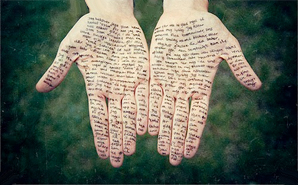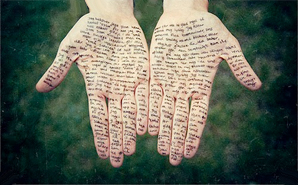



1. Nurses use their minds–and some nurses have very detail-oriented memories. But the mind is the least dependable and most rudimentary method of keeping track of what’s going on. But when nurses just can’t write stuff down–maybe they are running to the OR in an emergency or waiting for someone to document in a code–they have to rely on the ol’ noggin’.
2. An always-available alternative, provided the nurse hasn’t lost yet another pen with which to do her writing, is the hand. Hands can be used, then wiped clean for re-use with an alcohol swab, much like a dry erase board. The downfall is the latex glove, which sweats off hand ink. But in a pinch, hands can be that last ditch info-save.
3. Another trick is the paper-towel which can be grabbed and scrawled upon with haste. Towels are abundant in the hospital which works fantastically when paper can’t be found. Paired with a skin-marker in the OR, any nurse can look like s/he’s been in the field for at least 50 years! I knew of one nurse who actually used one such valuable paper-towel to dry her hands in a hurry and ruined it before she could record any of its intelligence. Plus, paper towels are not admissible to the chart, so all the info has to be rewritten somewhere valid.
4. Monitoring strip paper on telemetry or EFM machines are handy little strips of paper perfect for note-taking. The problem is that these are often admissible to the chart, so the stuff scrawled on these items better be court-worthy.
5. Scrubs work amazingly well as number-catchers. Many pairs of reusable OR scrubs bear permanent numbers and brackets tattooed all over them by docs and nurses alike. The problem is that ink does not come out of scrubs, even with in-house cleaning. Something that isn’t so permanent but works just as well is…
6. A piece of tape (Micropore or paper-tape works best) stuck to scrubs–usually on the thigh: These make amazing little go-anywhere notepads for the busy nurse. This is great in the OR for a circulating nurse and is not easily lost, but can be a bit weird to explain to patients who don’t understand why their nurse is running around with tape stuck all over their uniform. Not the most professional look.
7. Many nurses start their shift by grabbing a regular old piece of blank paper folded into fourths and use it (front and back) for up to 8 patients. This make-shift “brain” shares the same problem with…
8. The nurse brain:Â A “brain” is a pre-printed piece of paper with blanks that the nurse filled out for each patient. (Scrubs Magazine has done something wonderful and provided readers with all kinds of brains to download.) Most brains are unit-specific and very handy. Many a nurse has a bonefied panic attack when she “loses her brain” during a shift, and would probably pay good money to get it back.
9. Some units are kind enough to print out a census for use by each nurse on the shift. He or she can then jot down whats going on with their specific patients as well as what is happening on the unit as a whole. While this is GREAT for charge nurses, it can be a HIPAA nightmare if it finds its way off the unit in a tired nurses pocket or bag, so be careful in using this kind of mind “jogger.” Making a shredder trip prior to leaving the unit should be a habit for every nurse, anyway.
10. And lastly is the most expensive and seemingly least used mind-jogger: anything a nurse has to purchase. This includes post-it notes and those nice little spiral notebooks with wipe-able pages. While these may be great for new nurses, those who have paper/book addictions or are extremely organized, these can be cost prohibitive and possibly just not fast enough to get the job done. This nurse invested in costly “joggers” at the beginning of her career and they quickly ended up in a heap at the bottom of her tote-bag.
This is all about each nurse’s preference, of course. The point is, nurses often have to be creative in remembering all the little details of what they do, from times, to medications, to who they encounter on a case. Finding a jogger system that consistently works is unique to each individual, takes time and is a testament to how creative nurses really are in a pinch!
When we discuss students, we always mention their qualities. Those qualities show what they are…
If you or someone you know is juggling mental health issues alongside substance abuse, understanding…
For the last couple of weeks, the Israel-Hamas conflict has taken over the news cycle.…
Our eyes are invaluable, serving as our windows to the world. The ability to see…
Undoubtedly, one of the most demanding and challenging professions is nursing. Nurses work long hours in…
Echocardiography, or echo for short, is a key diagnostic test used by cardiologists to assess…